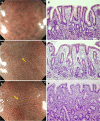Marginal turbid band and light blue crest, signs observed in magnifying narrow-band imaging endoscopy, are indicative of gastric intestinal metaplasia
- PMID: 23185997
- PMCID: PMC3543218
- DOI: 10.1186/1471-230X-12-169
Marginal turbid band and light blue crest, signs observed in magnifying narrow-band imaging endoscopy, are indicative of gastric intestinal metaplasia
Abstract
Background: Gastric intestinal metaplasia (IM) usually appears in flat mucosa and shows few morphologic changes, making diagnosis using conventional endoscopy unreliable. Magnifying narrow-band imaging (NBI) endoscopy enables evaluation of detailed morphological features that correspond with the underlying histology. The aim of this study was to investigate and clarify the diagnostic efficacy of magnifying NBI endoscopic findings for the prediction and diagnosis of IM.
Methods: Forty-seven patients were prospectively enrolled, and magnifying NBI examinations were performed in the lesser curvature of the midbody and the greater curvature of the upper body. The marginal turbid band (MTB) was defined as an enclosing white turbid band on the epithelial surface/gyri; light blue crest (LBC), as a fine, blue-white line on the crest of the epithelial surface/gyri. Immediately after observation under magnifying endoscopy, biopsy specimens were obtained from the evaluated areas.
Results: The degree of IM significantly increased with increasing MTB/LBC positivity (MTB(-)/LBC(-), 0.00 ± 0.00; MTB(+)/LBC(-), 0.44 ± 0.51; MTB(+)/LBC(+), 0.94 ± 0.24; p < 0.001). Moderate-to-severe IM was more common in MTB(+)/LBC(+) areas than in MTB(+)/LBC(-) areas (p < 0.001). For the diagnosis of IM, MTB had a sensitivity, specificity, and accuracy of 100%, 66.0%, and 81.7%, respectively, and the corresponding values for LBC were 72.1%, 96.0%, and 84.9%.
Conclusion: MTB and LBC observed in the gastric mucosa with magnifying NBI endoscopy are highly accurate indicators of the presence of IM. MTB likely represents a sign of early gastric IM, while LBC appears with progression to severe IM.
Figures



Similar articles
-
A new method of diagnosing gastric intestinal metaplasia: narrow-band imaging with magnifying endoscopy.Endoscopy. 2006 Aug;38(8):819-24. doi: 10.1055/s-2006-944632. Endoscopy. 2006. PMID: 17001572
-
Narrow-band imaging with magnifying endoscopy is accurate for detecting gastric intestinal metaplasia.World J Gastroenterol. 2013 May 7;19(17):2668-75. doi: 10.3748/wjg.v19.i17.2668. World J Gastroenterol. 2013. PMID: 23674874 Free PMC article.
-
Extending magnifying NBI diagnosis of intestinal metaplasia in the stomach: the white opaque substance marker.Endoscopy. 2017 Jun;49(6):529-535. doi: 10.1055/s-0043-103409. Epub 2017 Apr 10. Endoscopy. 2017. PMID: 28395383
-
Usefulness of magnifying narrow-band imaging endoscopy in the Helicobacter pylori-related chronic gastritis.Digestion. 2011;83(3):161-6. doi: 10.1159/000321799. Epub 2011 Jan 21. Digestion. 2011. PMID: 21266810 Review.
-
Markers of gastric intestinal metaplasia under digital chromoendoscopy: systematic review and meta-analysis.Eur J Gastroenterol Hepatol. 2021 Apr 1;33(4):470-478. doi: 10.1097/MEG.0000000000001834. Eur J Gastroenterol Hepatol. 2021. PMID: 32675780
Cited by
-
Advances in the Aetiology & Endoscopic Detection and Management of Early Gastric Cancer.Cancers (Basel). 2021 Dec 13;13(24):6242. doi: 10.3390/cancers13246242. Cancers (Basel). 2021. PMID: 34944861 Free PMC article. Review.
-
Diagnostic yield of the light blue crest sign in gastric intestinal metaplasia: a meta-analysis.PLoS One. 2014 Mar 21;9(3):e92874. doi: 10.1371/journal.pone.0092874. eCollection 2014. PLoS One. 2014. PMID: 24658503 Free PMC article.
-
Image-enhanced endoscopy in upper GI tract: State-of-the-art review.Indian J Gastroenterol. 2025 Sep 2. doi: 10.1007/s12664-025-01850-z. Online ahead of print. Indian J Gastroenterol. 2025. PMID: 40892129 Review.
-
Comparison of white-light endoscopy, optical-enhanced and acetic-acid magnifying endoscopy for detecting gastric intestinal metaplasia: A randomized trial.World J Clin Cases. 2021 Jun 6;9(16):3895-3907. doi: 10.12998/wjcc.v9.i16.3895. World J Clin Cases. 2021. PMID: 34141745 Free PMC article. Clinical Trial.
-
Magnifying endoscopy of gastric epithelial dysplasia based on the morphologic characteristics.World J Gastroenterol. 2014 Nov 14;20(42):15771-9. doi: 10.3748/wjg.v20.i42.15771. World J Gastroenterol. 2014. PMID: 25400462 Free PMC article.
References
-
- Correa P. A human model of gastric carcinogenesis. Cancer Res. 1988;48(13):3554–3560. - PubMed
Publication types
MeSH terms
LinkOut - more resources
Full Text Sources

